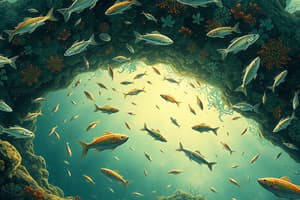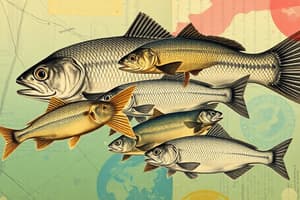Podcast
Questions and Answers
A fish species exhibits a regular migration pattern from freshwater habitats to marine environments to maintain osmotic balance. How would this migration be best classified?
A fish species exhibits a regular migration pattern from freshwater habitats to marine environments to maintain osmotic balance. How would this migration be best classified?
- Catadromous migration
- Alimentary migration
- Osmo-regulatory migration (correct)
- Anadromous migration
Which type of fish movement involves a passive transport with water currents, rather than active swimming?
Which type of fish movement involves a passive transport with water currents, rather than active swimming?
- Dispersal movement
- Contranatant movement
- Drifting movement (correct)
- Swimming movement
If a fish migrates upstream against the river's current to reach its spawning grounds, what type of movement is it exhibiting?
If a fish migrates upstream against the river's current to reach its spawning grounds, what type of movement is it exhibiting?
- Denatant movement
- Dispersal movement
- Alimentary movement
- Contranatant movement (correct)
What is the primary purpose of alimentary migration in fishes?
What is the primary purpose of alimentary migration in fishes?
During winter, salmon migrate from the sea to rivers for breeding purposes. Which type of migration does this represent?
During winter, salmon migrate from the sea to rivers for breeding purposes. Which type of migration does this represent?
What triggers gametic migration in fish?
What triggers gametic migration in fish?
How does dispersal movement differ from swimming movement in fishes?
How does dispersal movement differ from swimming movement in fishes?
What is the primary distinction between diadromous and osmo-regulatory migration?
What is the primary distinction between diadromous and osmo-regulatory migration?
What is the primary trigger for latitudinal migration in fish?
What is the primary trigger for latitudinal migration in fish?
Which physiological change is NOT typically associated with anadromous migration in fish?
Which physiological change is NOT typically associated with anadromous migration in fish?
Which of the following best describes potamodromous migration?
Which of the following best describes potamodromous migration?
What is the main purpose of shoreward migration in fish, as described in the text?
What is the main purpose of shoreward migration in fish, as described in the text?
European and American eels migrate to the Sargasso Sea to spawn, what type of migration is this?
European and American eels migrate to the Sargasso Sea to spawn, what type of migration is this?
Which of the following is a key adaptation observed in eels during catadromous migration, but NOT in salmon during anadromous migration?
Which of the following is a key adaptation observed in eels during catadromous migration, but NOT in salmon during anadromous migration?
Swordfish exhibit vertical migration patterns primarily for what purpose?
Swordfish exhibit vertical migration patterns primarily for what purpose?
A fish species migrates from the open ocean to coastal estuaries to spawn. This behavior is best described as:
A fish species migrates from the open ocean to coastal estuaries to spawn. This behavior is best described as:
Flashcards
Anadromous Migration
Anadromous Migration
Migration from saltwater to freshwater for breeding.
Catadromous Migration
Catadromous Migration
Migration from freshwater to saltwater for breeding.
Potamodromous Migration
Potamodromous Migration
Migration within freshwater habitats for feeding or spawning.
Oceanodromous Migration
Oceanodromous Migration
Signup and view all the flashcards
Latitudinal Migration
Latitudinal Migration
Signup and view all the flashcards
Vertical Migration
Vertical Migration
Signup and view all the flashcards
Shoreward Migration
Shoreward Migration
Signup and view all the flashcards
Migration Preparations
Migration Preparations
Signup and view all the flashcards
Animal Migration
Animal Migration
Signup and view all the flashcards
Alimentary Migration
Alimentary Migration
Signup and view all the flashcards
Gametic Migration
Gametic Migration
Signup and view all the flashcards
Climatic Migration
Climatic Migration
Signup and view all the flashcards
Osmo-regulatory Migration
Osmo-regulatory Migration
Signup and view all the flashcards
Juvenile Migration
Juvenile Migration
Signup and view all the flashcards
Study Notes
- Migration in ecology refers to the mass movement of animals from one location to another.
- The purposes of migration vary depending on the animal species.
- Fish migration is a common behavior mainly for feeding and reproduction.
Types of Fish Migration Based on Needs
- Alimentary or Feeding migration occurs when fish migrate to search for feeding grounds due to exhausted food resources.
- Gametic or spawning migration happens during breeding season as fish seek suitable spawning grounds.
- Climatic or seasonal migration involves fish migrating to find suitable climatic conditions.
- Osmo-regulatory migration is when fish migrate to balance water and electrolytes between sea and fresh water environments.
- Juvenile migration refers to the migration of larvae from spawning grounds to the feeding habitats of their parents.
Movement of Fishes During Migration
- Drifting movement is a passive movement of fish along with water currents.
- Dispersal movement involves random locomotion of fish from a uniform habitat to diverse directions.
- Swimming movement is an oriented movement of fish either toward or away from a stimulus source.
- Denatant and Contranatant movement is active swimming; denatant means swimming with the water current, while contranatant means swimming against it.
Types of Fish Migration
- Diadromous migration is the migration of fish between sea and fresh water.
- Most fish species are restricted to either fresh or saltwater, habitat changes can cause osmotic imbalance.
- Some fish regularly migrate between sea and fresh water and have perfect osmotic balance, making them true migratory fish.
- Diadromous migration has two types: anadromous and catadromous.
Anadromous Migration
- Anadromous migration is when marine fishes migrate from sea to fresh water for spawning.
- Fish spend most of their lives feeding in the sea.
- They typically migrate to rivers for spawning during the breeding season.
- Examples include Salmon, Hisla, and Lamprey.
- Salmon migrate for breeding during winter from sea to river, and physiological changes occur during migration.
- They stop feeding, change color from silver to reddish-brown, and their gonads mature.
- They construct a saucer-like nest for spawning, where the female lays eggs and the male releases sperm.
- Juvenile larva hatch from the eggs and are known as Alevins, which transform into parr, then metamorphose into adults before returning to the sea.
Catadromous Migration
- Catadromous migration involves freshwater fishes migrating from rivers to the sea for spawning during the breeding season.
- Examples include Eel (Anguilla spp).
- Both European eel (Anguilla anguilla or Anguilla vulgaris) and American eel (Anguilla rostrata) migrate from continental rivers to the Sargasso Sea off Bermuda for spawning, crossing the Atlantic Ocean.
- Before and during migration, physiological changes occur: fish deposit large amounts of fat, which serve as reserve food.
- Color changes from yellow to metallic silvery grey, the digestive tract shrinks and stops feeding.
- Eyes get enlarged, vision sharpens, and other sensory organs become more sensitive.
- Skin serves as a respiratory organ, and gonads mature and enlarge.
- Fish lay eggs in suitable spawning grounds, which are then fertilized by males; after spawning, the fish die.
- Larva hatch, develop into young eels, and eventually return to the river.
Potamodromous Migration
- Potamodromous migration is the freshwater migration of fish from one habitat to another for feeding and spawning.
- Examples include Carps and catfish.
Oceanodromous Migration
- Oceanodromous migration involves the migration of fish within the sea in search of suitable feeding and spawning grounds.
- Examples include Clupea, Thunnus, and Tuna.
Latitudinal Migration
- Latitudinal migration is the migration of fish from north to south and vice versa.
- It is a climatic migration.
- Sward fish migrate north in spring and south in autumn.
Vertical Migration
- Vertical migration is the daily migration of fish from deep to the surface and vice versa for food, protection, and spawning.
- Sward fish usually move vertically downward to greater depths for food.
Shoreward Migration
- Shoreward migration is the migration of fish from water to land, but it is a temporary migration.
- Eel can migrate from one pond to another via moist meadow grass.
Significance of Fish Migration
- To find suitable feeding and spawning grounds.
- For protection from predators.
- To survive extreme climatic conditions.
- Increases genetic diversity.
- It is an adaptational characters for survival and existence.
Studying That Suits You
Use AI to generate personalized quizzes and flashcards to suit your learning preferences.




